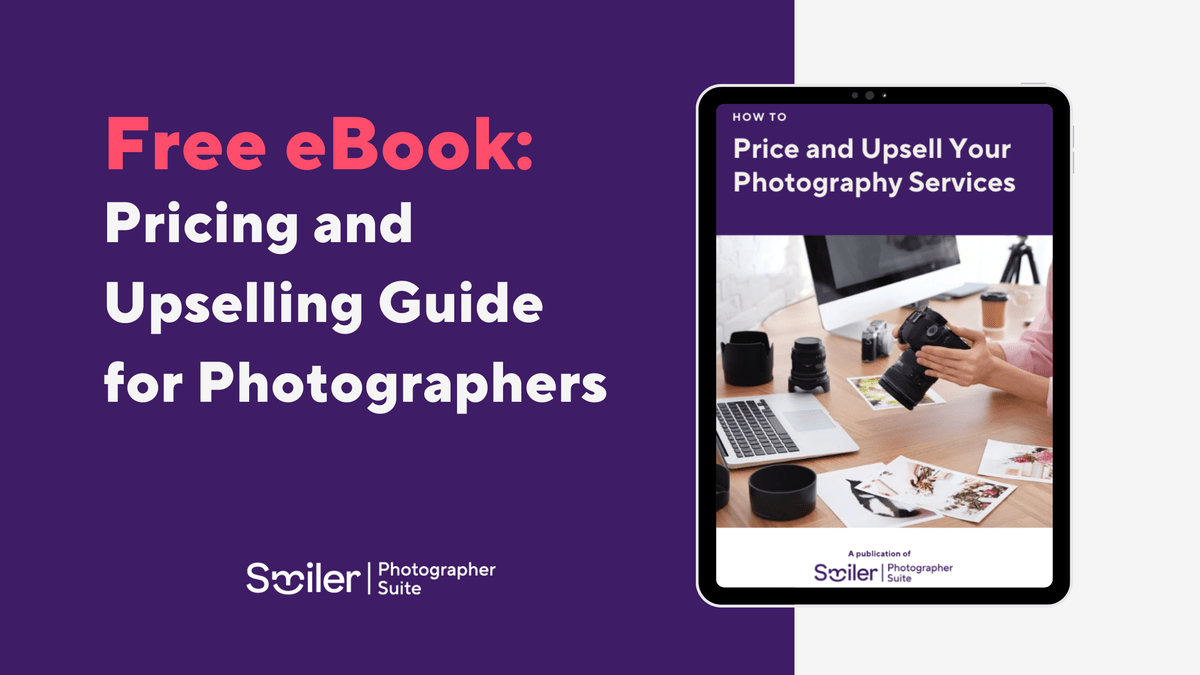The Beginner’s Guide: How to Price Your Photography Services

For many in the creative field, figuring out what to charge for their services can be a frightening task. It's all about finding the right balance between setting prices that are competitive and making sure you still make a decent profit.
If you’re wondering, “How much should I charge for my photography services?”, this article is for you! Today, we'll cover the basics of what things you need to think about when setting your prices for photography services.
Whether you're just starting out or trying to grow your photography business, adopting the correct approach and utilising the right software and tools can assist you in establishing a pricing model that truly reflects your work!

Download your free eBook to learn more about pricing and upselling strategies.
Main pricing models
When considering a new pricing strategy for your photography services, it's important to take into account all your costs and time involved in a session. Photography isn't just about the time spent during the shoot itself; it includes various tasks such as consultations, locations selecting, editing, delivering photos, and even the time spent traveling to and from the shoot.
Hourly rate pricing
Many photographers, especially with wedding photography and event photography specialisation, commonly opt for an hourly fee structure. This approach ensures that you're compensated for all the time you dedicate to capturing the event. If the event stretches on longer than expected and requires you to stay beyond the agreed time, you are still covered for the additional hours based on the previously agreed rates per hour.
When considering hourly rate pricing model, it's essential to carefully research the average hourly rates for photographers in your area to ensure you remain competitive. Additionally, factor in any time spent before and after the event, such as travel, client consultations, preparation, and post-production, when determining your final charge.
Flat fees
Alternatively, some photographers go for a flat rate, which is considered transparent and approachable by freelance photographers. This means you provide a set price for the entire photo shoot, regardless of the time spent or the number of photos delivered. The benefit of this approach is that it gives you control over your income and workflow where you won't have to negotiate extra hours or expenses with clients.
However, it can be challenging to estimate and justify the price to clients since you need to consider all expenses and risks involved, such as travel, equipment, editing, or licensing. When done poorly, you might end up working more than expected or underpricing your services.
Checking the rates for photo shoots in your area can offer helpful guidance in this regard. As long as you are aware of the time required for capturing and editing the specified number of images, you can confidently offer a flat fee for your services.
How to know you're using a model that suits you
Well, let's say you've gone through all this guidance and settled on a pricing list for your photography services. How do you make sure you're doing it right? You've likely noticed that after considering your expenses, pricing your photography services can feel somewhat subjective. Good news is, finding the perfect balance takes some trial and error. The most reliable method to gauge if your photography pricing list is accurate is by putting it to the test in the market!
When deciding between different pricing models for your photography services, you'll notice that both options has its own advantages and considerations. It's important to do thorough research to determine which one aligns best with your business model and goals. So let's talk about the most important thing that'll keep you from spending more money than you earn.
Understanding your costs
The number one rule in any business is to have a clear understanding of your operational expenses. Otherwise, you might end up mistakenly considering too much of your income as profit.
Now, what exactly do we mean by 'operational expenses'? Operational expenses encompass all the costs associated with running your business on a day-to-day basis. For studios it could be rent or mortgage payments, utilities such as electricity and internet, salaries or wages for employees. For freelance photographers, it could be the marketing and advertising expenditures, insurance premiums, equipment maintenance, and any other regular expenses necessary to keep your business operational.
By being aware of and accurately accounting for your operational expenses, you gain a more realistic understanding of your financial health and can make informed decisions about pricing, budgeting, and resource allocation. This awareness also helps you avoid unpleasant surprises and ensures that your business remains sustainable and profitable in the long run.
While understanding your operational expenses is crucial, there's also another aspect that often gets overlooked (especially in creative fields like photography). When you're passionate about your work, it's easy to underestimate the value of your labor. This is the flip side of pursuing a career in a creative field – just because you love what you do doesn't mean it's not hard work.
Try Smiler's free Photographer Suite to reduce costs
Navigating operational costs as an entrepreneurial photographer can be daunting. While you're eager to start generating income, high operational costs can become a significant barrier to getting your business off the ground. This is where the Smiler Photography Suite comes in – it offers you the tools to manage your business and time more efficiently without compromising your profitability.
As a photographer, you're responsible for wearing many hats in your business. From handling client inquiries and guiding them through their shoots to editing photos and showcasing your latest work online - the workload can be overwhelming. Without the ability to expand your team or delegate tasks, your booking capacity may be limited, potentially tiring you in the process.
With the Photographer Suite's exclusive features like upselling, review collection, and flexible payment options, it addresses every aspect of your workflow seamlessly. The best part? Everything you need is consolidated into one convenient platform. And the perks don't stop there:
- No monthly subscription, signup fee, or hidden costs
- Send unlimited client galleries for free
- No processing fees for Visa, Mastercard, PayPal, and six other international payment methods
The Smiler Photographer Suite is designed to liberate you from the countless hours typically consumed by the administrative tasks of running a photography business. This means more time for your art and personal life.

Download your free eBook to learn more about pricing and upselling strategies.
Competitive pricing
When considering how to price your services, experienced photographers often advise examining other local businesses in your area. Take some time to do market research specifically within your photography niche, whether it's weddings, portraits, or commercial work. This will give you a good idea of how your pricing stacks up against others. And as your clients would be doing a similar research, it's important to know what they'll come across as well.
If you find that your pricing exceeds the average rates in your local area, but you firmly believe it's justified, you'll need to skilfully communicate the value of your services to your clients. This communication is crucial for convincing them to recognise the value of investing in your work at that rate.
Seasonal and demand-driven pricing
Seasonal and demand-driven pricing strategies are essential for building a dynamic pricing model, especially within the photography industry. These strategies involve adjusting prices based on fluctuations in demand and seasonal trends to optimise revenue and meet consumer expectations effectively.
During peak seasons or high-demand periods such as holidays, wedding season, or special events, you may experience an increase in inquiries and bookings. In response, you can adjust your pricing to reflect the heightened demand for your services.
Conversely, during off-peak seasons or slower periods, you can offer discounted rates or special promotions to stimulate demand, fill your schedule, and prevent revenue stagnation.
Seasonal factors such as weather conditions, cultural events, and industry-specific trends can influence pricing decisions. Implementing seasonal and demand-driven pricing requires careful analysis of market dynamics, competitor pricing strategies, and customer preferences. When you gather all this data, consumer insights, and forecasting techniques, you can develop a strategy that maximise your profitability while remaining competitive in the market.
Wrapping up
Every minute you spend on your craft, whether it's during a photo shoot or editing afterwards, has real value and should be accounted for in your pricing. It's important to be honest with yourself about how much time each project requires. While it might be tempting to discount your time, every moment you're actively engaged in your work contributes to its quality and deserves compensation.
So, when determining your pricing, make sure to factor in all the hours you invest in each project. Your time and expertise are valuable, and you deserve to be fairly compensated for them!
What's next?
We hope that this photography pricing guide will help you pave the way for your success. If you like to learn more about the best practices for your photography business; browse our growing collection of articles in our blog containing useful tools, techniques, and best practices. Many of these insights come straight from the mouths of successful professional photographers!
Would you like to check out the Smiler Photographer Suite and see how it can improve your photography business? Sign up for free now and discover why photographers rave about it!

